
Image Credit: ACROBiosystems
Multiple sclerosis (MS) is a central nervous system immune-mediated inflammatory demyelinating disease. A relapsing-remitting course, a progressive disease course, or a combination of the two may define the clinical course of MS.
There are about 2 million MS patients globally, and it is the most prevalent cause of permanent disability in young adults, aside from traumatic brain injury, resulting in a significant socioeconomic burden. In the United States alone, there are approximately 1 million individuals with MS, with associated costs exceeding $24 billion.
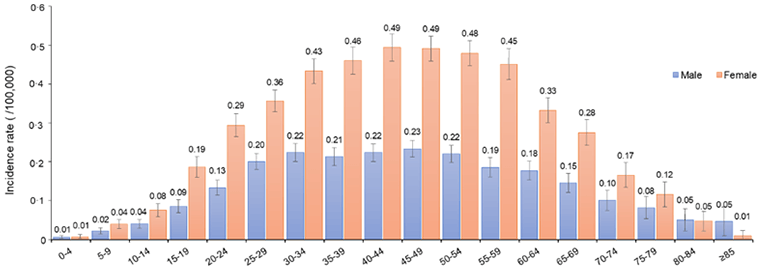
Prevalence of MS in different age groups. Image from reference
Pathology and etiology of MS
The pathological damage in MS consists of gliosis, inflammatory demyelination, and sclerotic plaque formation. In the past few years, it has been displayed that MS can also result in primary axonal damage and neuronal degeneration. This exhibits damage to the gray matter of the brain, practically the cerebral deep gray matter.
MS has a complex etiology and pathogenesis, and various clinical and experimental studies have already shown that it is caused by a combination of genetic and environmental factors:
- Genetic factors encompassing both ethnicity and separate susceptibility
- Environmental factors include environmental pollution, viral infections, frequent immunizations, genetically altered foods and several surgical traumas, amongst several others
Pathogenesis of MS: Molecular mimicry
Experimental virological and immunological studies have disclosed that when a virus attacks the body, mononuclear macrophages in the body phagocytose and digest the virus and send the viral antigen signal, sharing antigenicity with myelin basic protein, to helper T cells.
This helps trigger the CNS, then activate effector T cells, discharge a large number of cytokines, and activate complement and B cells. This results in oligodendrocyte degeneration and myelin damage—eventually resulting in MS pathogenesis.
Various researches on animal models of experimental autoimmune encephalomyelitis (EAE) have confirmed this hypothesis, which is now widely recognized as molecular mimicry.
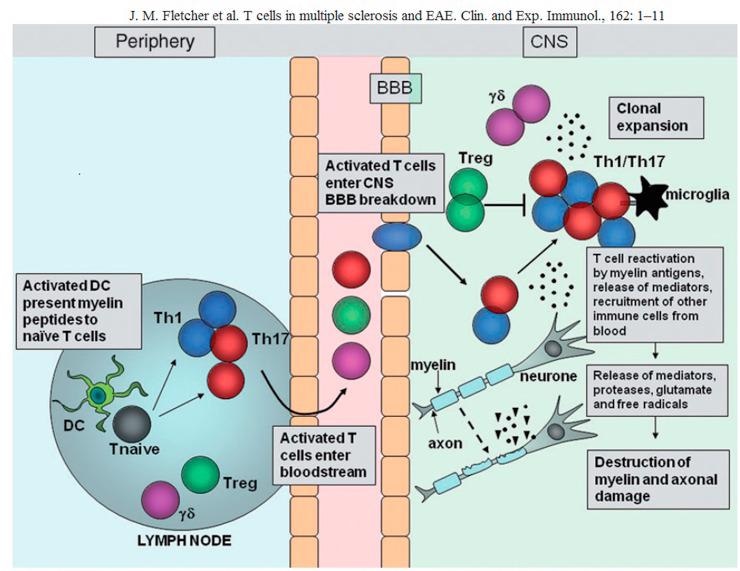
T-cell migration in the central nervous system during experimental autoimmune encephalomyelitis (EAE). Image Credit: Fletcher et al., 2020
Drugs for MS
Small chemical molecules, monoclonal antibodies, and interferons are among the more than 20 drugs approved for the treatment of MS around the world.
Glucocorticoids were majorly employed for the early treatment of MS, but they were proven useless in reducing several relapses and the rate of disease progression; in the 1990s, interferon was utilized in the clinical treatment of the disease.
In 1996, the bulky product glatiramer acetate was marketed; since then, various oral small-molecule chemical drugs and monoclonal antibodies have been initiated, thereby offering numerous avenues for the treatment of MS.
MS-related therapeutic targets
The integrin alpha-4 (ITGA4) gene is considered to be one of the genetic factors that impact MS pathogenesis. Also, the encoding of ITGA4 helps in the migration of leukocytes throughout the blood–brain barrier in MS.
Thus, ITGA4 is known to be a potent therapeutic target for MS. Natalizumab, developed for this target, was accepted by the US FDA in 2004 to treat MS and Crohn’s disease. Natalizumab efficiently treats symptoms of both diseases, thereby increasing remission rates and, avoiding relapses, cognitive decline, and vision loss, and considerably enhancing the quality of life in MS patients.
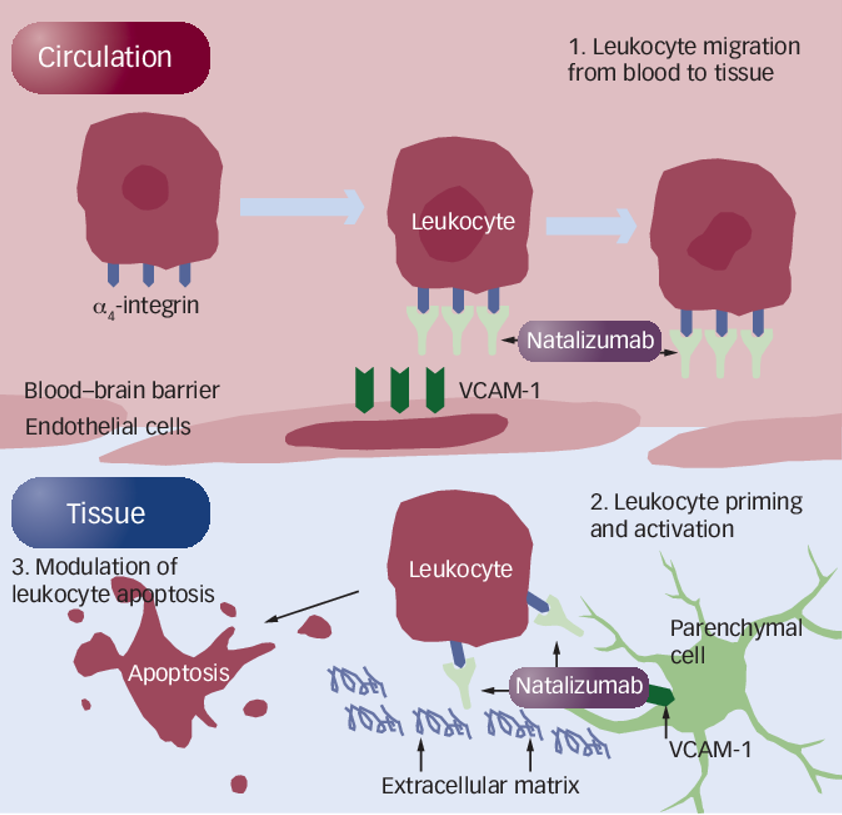
Mechanism of action of natalizumab in the treatment of MS. Image from reference
The interferon-alpha/beta receptor alpha chain (IFNAR1) gene encodes a type I membrane protein that adds up one of the two chains of interferon α and β receptors. The receptor for type I interferon includes two subunits, IFNAR1 and IFNAR2.
Binding of type I IFN by IFNAR1 activates the JAK-STAT signaling pathway, which is essential for regulating growth, survival, differentiation, pathogen resistance, and antiviral immunity, triggering many protein IFN/IFNAR1 activation of immune mechanisms is also an important target for MS therapy.
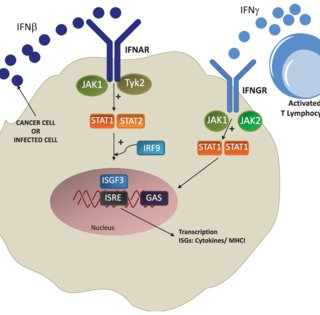
Signal pathway of IFN/IFNAR1. Image from reference
Sphingosine-1-phosphate receptor 5 (S1PR5) has been expressed predominantly in CNS white matter bundles and considerably expressed by oligodendrocytes and is involved in and controls natural killer cell trafficking.
Modulators that target S1PR are a comparatively new class of therapies, being the first oral therapy for MS, the first approved for pediatric MS, and also the first to prove efficient in secondary progressive MS (SPMS).
Its main mechanism of action is via binding to S1PR isoforms on lymphocytes, thereby resulting in receptor internalization and loss of responsiveness to the S1P gradient that propels lymphocyte drainage from lymph nodes.
The decrease in circulating lymphocytes might restrict the migration of inflammatory cells to the CNS. Four S1PR modulators (fingolimod, Siponimod, ponesimod, ozanimod) have been approved to treat MS.
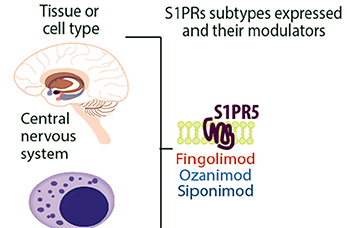
S1PR5 expression in the CNS system. Image from reference
Ocrelizumab, a monoclonal antibody targeting CD20, was approved for marketing in March 2017 as the first drug for main progressive MS. New clinical studies have displayed that the use of Rituximab in patients with relapsing–remitting MS led to a quick reduction of B cells, as well as myelin lesions and clinical relapses, with impacts lasting around 3 to 12 months.
In a phase II study of Rituximab in patients suffering from relapsing–remitting MS, a considerable decrease in MRI and clinical markers of disease activity were displayed. Around 104 patients with RRMS were assigned randomly to 2 × 1000 mg of intravenous Rituximab or placebo and tracked for around 48 weeks.
The Rituximab group displayed a considerable decrease in various contrast-enhanced MRI lesions (p < 0.001) and T2 lesion volume (p = 0.04) at weeks 24 and 36, respectively, compared to the placebo group. Furthermore, the Rituximab group decreased the annualized MS recurrence rate, statistically significant at week 24 but not at week 48.
CD52 is a cell surface antigen that is present on all monocytes and lymphocytes. Alemtuzumab, a humanized monoclonal antibody targeting CD52, was approved for marketing by the FDA in May 2001 for leukemia treatment and was given MS orphan drug status by Mexico in 2014.
Two-phase III clinical studies verified the effectiveness of alemtuzumab, with a 55% lower annual relapse rate and similar disability progression rates than interferon. But because alemtuzumab has serious adverse impacts, especially secondary autoimmune disease, in 2019, the European Medicines Agency suggested that alemtuzumab must be restricted for use in adults with MS.
Summary
MS is a central nervous system immune-mediated disorder that can lead to severe disability and a reduction in quality of life. Monoclonal antibodies targeting a variety of immune pathways have made significant advances in MS treatment outcomes following a better understanding of the disease’s pathogenesis and disease process.
Relapsing disease and focal brain inflammation are now nearly completely under control thanks to the advancement of extremely effective therapies.
However, the efficacy of disease-progressing therapeutics remains insufficient, as treatment options only provide partial protection against MS-related neurodegenerative lesions.
An evidence-based, personalized approach to MS treatment and management that promotes early treatment is the need of the hour. Ultimately, new techniques are being developed to identify and evaluate the remyelination ability and neuroprotective capacity of drugs, which will help to promote ongoing MS therapeutic advances.
Aneuro concentrates on brain science research and the development of MS drugs and therapeutics, and it can offer additional integrin alpha-4 (ITGA4), interferon-alpha/beta receptor alpha chain (IFNAR1), CD20, CD52, and other target proteins, as well as more MS diagnosis and treatment-related proteins (including S1PR5).
References
- Tian DC, Zhang C, Yuan M, Yang X, Gu H, Li Z, Wang Y, Shi FD. Incidence of multiple sclerosis in China: A nationwide hospital-based study. The Lancet Regional Health. 2020 Aug 6;1:100010. DOI: 10.1016/j.lanwpc.2020.100010
- Cavallo S. Immune-mediated genesis of multiple sclerosis. Journal of Translational Autoimmunity. Jan 28;3:100039. DOI: 10.1016/j.jtauto.2020.100039
- Constantinescu CS, Farooqi N, O'Brien K, Gran B. Experimental autoimmune encephalomyelitis (EAE) as a model for multiple sclerosis (MS). British Journal of Pharmacology. 2011 Oct;164(4):1079-106. doi: 10.1111/j.1476-5381.2011.01302.x.
- Bates, David W. “Natalizumab (Tysabri®) – Redefining Efficacy in Multiple Sclerosis – Data from Clinical Trials to Postmarketing Experience.” (2010)
- Gonzalez-Cao M, Karachaliou N, Santarpia M, Viteri S, Meyerhans A, Rosell R. Activation of viral defense signaling in cancer. Therapeutic Advances in Medical Oncology. 2018 Aug 29;10:1758835918793105. https://journals.sagepub.com/doi/10.1177/1758835918793105.
- Mark B. Skeen, MD. Sphingosine-1-Phosphate Modulators for Multiple Sclerosis. https://practicalneurology.com/articles/2020-feb/sphingosine-1-phosphate-modulators-for-multiple-sclerosis
About ACROBiosystems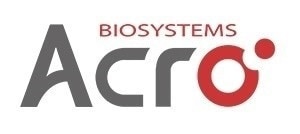
ACROBiosystems is a cornerstone enterprise of the pharmaceutical and biotechnology industries. Their mission is to help overcome challenges with innovative tools and solutions from discovery to the clinic. They supply life science tools designed to be used in discovery research and scalable to the clinical phase and beyond. By consistently adapting to new regulatory challenges and guidelines, ACROBiosystems delivers solutions, whether it comes through recombinant proteins, antibodies, assay kits, GMP-grade reagents, or custom services. ACROBiosystems empower scientists and engineers dedicated towards innovation to simplify and accelerate the development of new, better, and more affordable medicine.
Sponsored Content Policy: News-Medical.net publishes articles and related content that may be derived from sources where we have existing commercial relationships, provided such content adds value to the core editorial ethos of News-Medical.Net which is to educate and inform site visitors interested in medical research, science, medical devices and treatments.